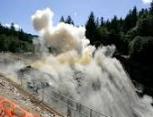 Removing 4 Lower Snake River Dams Just a Bad Idea
Removing 4 Lower Snake River Dams Just a Bad Idea
Don Brunell, President Washington Business
There are dams that should come down and those that shouldn’t.
Demolishing the two dams on the Elwha River west of Port Angeles is a good thing and, hopefully the salmon and steelhead will return in record numbers. The dams were built in the early 1900s to bring electricity to the Olympic Peninsula at a time when salmon and steelhead were plentiful in other Pacific Northwest rivers.
On the Elwha River, the issue was clear: Two barriers were blocking salmon from moving upstream. The care with which the demolition was planned, studied and implemented is a credit to all involved, and now fish can swim up to the high mountain tributaries in the Olympics to spawn and start the life cycle over again. But breaching the four lower Snake River dams is an entirely different matter. For one thing, the billions of dollars paid by Bonneville Power ratepayers to improve fish passage and spawning habitat throughout the Columbia and Snake River system is now paying off — salmon are moving up the Columbia and Snake rivers in great numbers.
Last year, the Idaho Fish and Game Department reported that 1,070 sockeye returned to Redfish, and the Columbia River Inter-Tribal Fish Commission counted more than 27,000 adult fall chinook above the Lower Granite dam, the uppermost dam on the river.
Replacing the electricity generated by the Snake River dams would take two nuclear plants, three coal-fired generators and six gas-fired power plants. Hydropower is the most efficient way to generate electricity, capable of converting 90 percent of the available energy into clean electricity.
Wind turbines, on the other hand, are only about 30 percent efficient at best.
Marine Highway Another difference between the Elwha and Snake River dams: Ice Harbor, the westerly most of the lower Snake River dams, irrigates 36,000 acres of farmland, vineyards and orchards.
Consider also the marine highway created by the Columbia and Snake rivers is the most environmentally friendly way to move cargo from Lewiston to Astoria.
Barging keeps 700,000 trucks off Northwest highways every year, and barges are extremely fuel-efficient, moving a ton of goods 576 miles on a gallon of fuel, compared with 413 miles for rail and 155 miles for trucks.
A plan exists to carefully manage the Columbia and Snake rivers for the benefit of both fish and people. A comprehensive management plan which became
known as the Biological Opinion or “Bi-Op”, was supposed to be implemented two years ago, but U.S. District Judge James Redden, who recently retired, blocked it saying that spilling water to allow young salmon to migrate to the ocean wasn’t good enough. He told Idaho Public TV reporter Aaron Kunz that there was no need to go to the expense of demolishing the dams. “You just dig a ditch and let the river go around them.”
All this nonsense about digging a ditch around those four massive structures is just that — nonsense. We should thank our lucky stars the four lower Snake River dams are there and get on with implementing the cooperative management plant that allows both fish and families to thrive.
Disclaimer: Articles featured on Oregon Report are the creation, responsibility and opinion of the authoring individual or organization which is featured at the top of every article.

